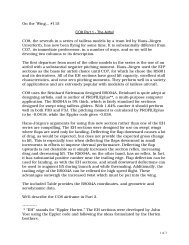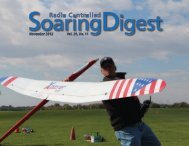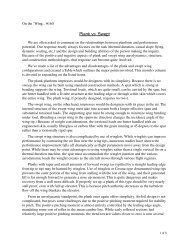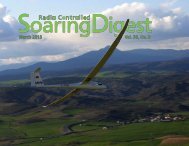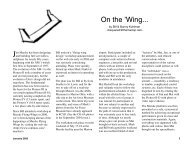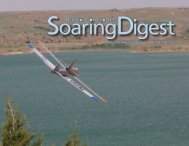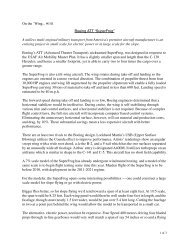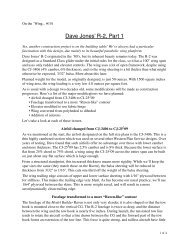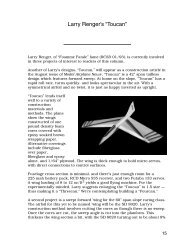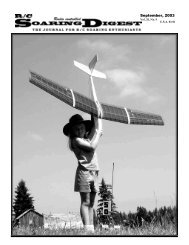Larry Haig's Minibat - Radio Controlled Soaring Digest
Larry Haig's Minibat - Radio Controlled Soaring Digest
Larry Haig's Minibat - Radio Controlled Soaring Digest
- No tags were found...
You also want an ePaper? Increase the reach of your titles
YUMPU automatically turns print PDFs into web optimized ePapers that Google loves.
together at the leading edge by J-joint, and at the trailing edge by the molded rear spar. Theelevators and ailerons are made from molded glass upper and lower surfaces over glass and foamribs. The wing halves attach internally at the centerline with pins. Additional wing panels of aboutfour foot length became available to increase the wing span and decrease the wing loading. Theseextensions substantially improved gliding performance.The fuselage is built in the same way as the wings, except there is no spar cap. The outer skincarries the bending loads and the inner skin carries the torsional loads. Reinforcement is providedin the area of the landing gear, tail skid, etc. Besides a J-joint on the outside, the fuselage is tiedtogether on the inside by the seat, armrests and keel.The fin and rudder are constructed like the ailerons and elevators — glass skins are placed overfoam ribs.AirfoilPerhaps the most problematic component of the <strong>Minibat</strong> is the airfoil. A Liebeck section(maximum camber at 20% chord, camber = 5.5%, thickness = 14.5%) was used in an effort toachieve a high coefficient of lift. The Liebeck airfoil was one of the first computer-designedsections, and the code at that time was not reliable. It was predicted that the section would achievea maximum coefficient of lift of at least 1.4 while not having the excessive drag of other high liftsections. Evaluating the Liebeck section with modern computer codes, the Liebeck section doesnot live up to its expectations.• The upper surface does not behave well at Reynolds numbers below three million. A goodsailplane section should be good down to Re = 500K or lower, depending on the local wing chord.The <strong>Minibat</strong> mean chord is 30 inches, and the Reynolds number in slow flight is around onemillion. The wing tips just cannot produce enough lift, and the reaction of the pilot is to feed inmore up elevator. Up elevator produces a large down force, counteracting the lift generated by thewing. Jim Marske predicted that the maximum coefficient of lift of about 0.8 under theseconditions, just 60% of the predicted value.• The bulbous protrusion on the lower surface near the leading edge causes a large amount of dragat high speed. As the angle of attack decreases, this area acts as a lower surface spoiler. Poor uppersurface boundary layer control at low speeds and this lower leading edge protrusion which causesexceptional drag at high speed severely limit the speed range of this section.• Because of the upper surface behavior at low Reynolds numbers, the ailerons on the <strong>Minibat</strong> donot start operating until the aircraft has nearly reached flying speed.• The Liebeck section is not so stable as had been originally thought. In fact, some amount of upelevator trim is required for stable flight. This is not a problem in the <strong>Minibat</strong>, as the elevator islarge, but it is something to keep in mind.Since the Liebeck section performs so poorly on full size aircraft, its performance on a model,even at half size, can be easily predicted to be abysmal. We’ve looked through our collection ofairfoils and found what we believe to be a suitable replacement.Dave Jones was a prolific designer of airfoils for use on plank planforms. Rather than usesophisticated airfoil design programs, Dave utilized relatively simple mathematical formulae to3 of 7



